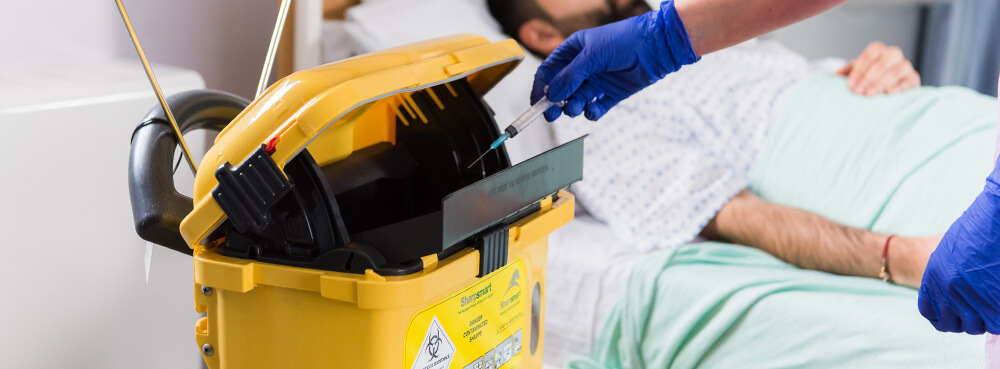Know the Do’s and Don’ts of Sharps Disposal

Do wash your hands. Do eat vegetables regularly. Don’t run with scissors. Don’t pick your nose. These are Do’s and Don’ts we’re familiar with; but are you aware of the ramifications of improper sharps disposal? If you’re not, you might be in big trouble.
Failure to adhere to local and national regulations regarding the proper sharps disposal and containment methods inside the four walls of your facility, can result in massive financial ramifications as well as damage to your reputation. Any facility, regardless of size or treatment options, is responsible for proper healthcare waste segregation and disposal of clinical sharps.
Just to be clear, sharps don’t merely imply needles, but also include scalpels, knives, infusion sets, and broken glass – specifically anything with a sharp edge to it. Basically, a sharp is anything that could potentially puncture skin. This is especially true when such items have come into contact with blood, potentially infectious body fluids, or pose a danger to humans or the general public.
Improperly discarded needles or other sharps not only pose dangers to immediate employees or healthcare workers due to potential for needlestick injury or other sharps injury, but have the potential to transmit infectious diseases such as hepatitis or human immunodeficiency virus (HIV) to the public at large.
Be good
- Follow guidelines in regard to sharps bin placement and use safety-engineered sharps containers to reduce sharps injury. Your sharps container should be FDA-approved and meet the ISO-23907-2 standard. In addition, perform due diligence and understand local regulations and national guidelines for not only optimal sharps bin placement, but safe sharps removal service protocols.
- Prior to disposal, a sharps bin (or sharps container) should always be sealed, reducing the risk of needlestick injury by those collecting the waste or during the transportation and disposal of such waste.
- Sharps bins must be properly labeled according to national guidelines.
Don’t be bad
- Don’t, ever, ever, put sharps waste (or an uncapped syringe) into a nonregulated plastic bag, trashcan, or flush it down the toilet. This is true for both healthcare facilities of any kind (human or veterinary), as well as home-based usage. Home-based users who don’t have a properly regulated sharps container may temporarily put used sharps or needles into a solid, heavy duty plastic container such as a laundry detergent or bleach bottle, but it must be clearly labelled and properly disposed of. In such cases, check with local authorities regarding proper disposal methods.
- Obviously, be aware of ideal sharps container placement to avoid contact with children, other adults, or pets. This is important in any healthcare facility or home environment
Note: Individual users of sharps for medication delivery, insulin delivery, or other reasons should contact local public health departments as well as local waste management to determine proper regulations and disposal programs in the area. A good source for such information is your healthcare provider or hospital. After receipt of such information, verify with appropriate organisations (EPA, State Department of Health and Human Services) that the information is accurate.
- Never put sharps into a recycling bin. Because used sharps may have been contaminated with blood or other infected body fluids, they are considered infectious waste and will not be recycled.
- A common practice in the past has been to break or bend used needles to ensure that they can’t be used by someone else after they’ve been disposed of. However, this increases the risk of a needlestick injury by the individual doing the breaking, or if such waste is found in a trashcan, a street waste bin, or the local landfill.
Rules and regulations of proper sharps disposal
A number of governmental agencies provide in-depth information regarding sharps safety. These safety issues apply to anyone responsible for handling sharps as well as to their disposal. Roughly 100,000 sharps injury or needlestick injury scenarios occur in the United Kingdom on a yearly basis. These numbers are specific to hospital-based facilities. This doesn’t apply to other facilities where needles are often used, such as:
- long-term care or rehab facilities
- private homes
- clinics
- emergency services such as urgent care
Needlestick injuries have the potential to transmit dozens of pathogens in addition to the biggies:
- Hepatitis B virus (HBV)
- Hepatitis C virus (HCV)
- Human immunodeficiency virus (HIV)
Regulations are on the books in regard to proper sharps usage, disposal, transportation, and destruction.
Guidelines and regulations can be confusing and convoluted. With decades of experience in the industry, we can help. Improper sharps disposal isn’t a casual “oops,” it has real consequences for real people. Don’t take risks that lead to staggering fines and potential ramifications of non-compliance. Call us. Sharpsmart is dedicated to safety, and providing guidance on environmentally responsible waste segregation and proper sharps container usage, placement and sharps disposal techniques. Sharps injury reduction is an imperative in today’s healthcare environment. We know the rules. We know the laws and regulations when it comes to compliance and needle safety legislation. Learn here how Sharpsmart has “changed the game” in the safe disposal of healthcare sharps, with proven ELIMINATION of container-associated needlesticks.
Let's Talk!
Your time is valuable, and we don’t want to play hard to get. You can either phone us directly on the details listed on our contact page, or feel free to fill out this short form and one of our team members will get back to you as quickly as possible.
